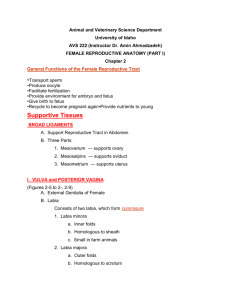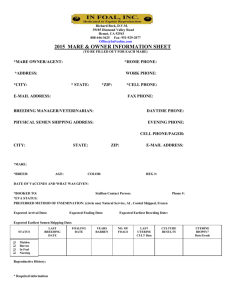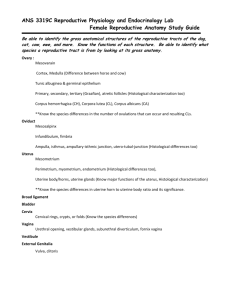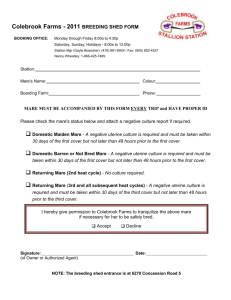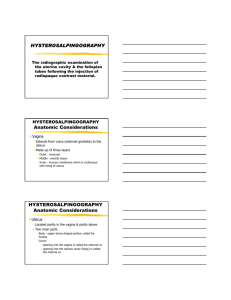Comparative female anatomy, historical perspectives
advertisement
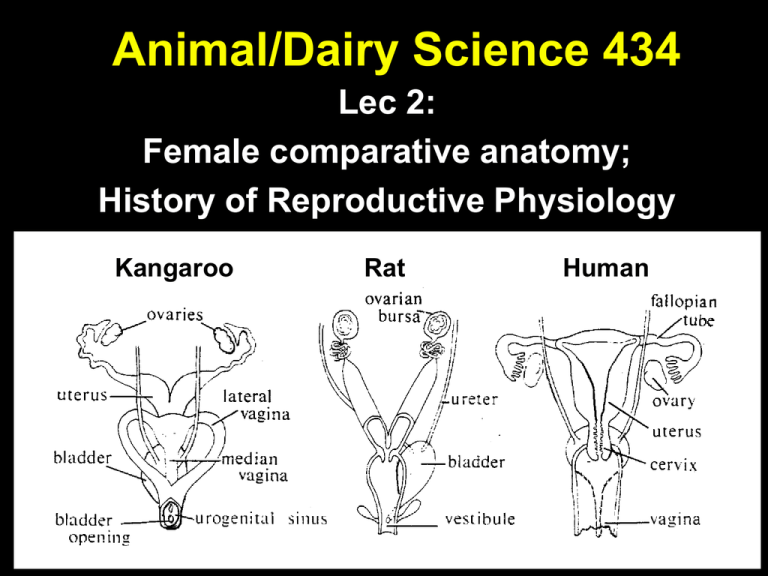
Animal/Dairy Science 434 Lec 2: Female comparative anatomy; History of Reproductive Physiology Kangaroo Rat Human Ovarian Differences Mare Cow Sow Cow Sow Cow, Sow, Ewe, Human • Cortex on outside • Ovulation can occur on any point of the ovary Mare • Inversion of the cortex and medulla. • Ovulation occurs at the Ovulation Fossa Preovulatory Tertiary Follicle Internal CL Mare Blood vessels and connective tissue in medulla Uterine and Cervical Differences Sow Cow Mare Advanced Duplex (Opossum) Duplex (Rabbit, Mouse) Two Uterine Horns Two Cervices Bicornuate (Pig) Two Uterine Horns Two Uterine Horns (long) Two Cervices One Vagina Common Uterine Body One Cervix Two Vaginas One Vagina Smaller Uterine Horns Bicornuate (Cow, Ewe, Doe) No Uterine Horn, All Uterine Body Simplex (Human) Larger Uterine Body with Smaller Uterine Horns Bicornuate (Mare) Human Tract Human Tract Mare SOW Uterine Body Uterine Body Longitudinal Folds There are no obstacles in the mare after the fornix vagina Cervix Cervix Sow cervix has many interdigitating pads Note: Sow does not have fornix vagina Os Cervix Os Cervix Fornix Vagina Vagina Vagina Cervix COW Internal Os Cervical Ring Cervical Ring Fornix Fornix External Os Anterior Vagina EWE Fornix Anterior Vagina Cervix Cervica l Folds FV IP Sow Mare External Genitalia Mare Cow Sow Ewe Human Tract External Genitalia Vagin a Anterior Vagina Posterior Vagina (Vestibule) Cervix Fornix Columnar Epithelium Urethra Stratified Squamous Epithelium VulvaVaginal Sphincter Mucosa Submucosa Submucosa Avian Female Anatomy Ovary Infundibulum perivitelline membrane chalazae albumen Magnum Oviduct shell membrane Isthmus Uterus Shell Gland Intestine Right Oviduct cleaving blastodisc vagina shell cloaca Left side of Reproductive Tract Develops!! Chicken Ovary Hierarchical Follicular Status Chicken Tract Shell Gland Oviduct Ovary Historical Development of Reproductive Physiology Aristotle 384-322 BC • Fetus arises from Generation of Animals menstrual blood • Seminal plasma initiates the conversion of menstrual blood • Semen from all parts of body Historical Development of Reproductive Physiology • Fallopius (1562) – Describes the oviduct • Coiter (1573) – Describes the corpus luteum • Regnier de Graff (1672) – Describes the antral follicle (Graafian Follicle) • van Leewenhoek (1677) – Develops the microscope – Describes spermatozoa in semen Historical Development of Reproductive Physiology • Spallanzani (1780) – Sperm were the fertilizing agent in semen – Successful artificial insemination of a dog • Dumas (1825) – Proves sperm the fertilizing agent Modern Reprod. Physiology • • • • • • Gonads produce steroid hormones Cyclicity in females Radioimmunoassay (RIA) Artificial Insemination Semen Cryopreservation Prostaglandin used to control estrous cycles • Biotechnology Approach to Applications • Develop basic knowledge of how system works • Investigate methods that can perturb the system • Manipulate the system to improve reproduction Enhancing Reproduction • Small improvements have profound effects on production – 3% improvement in birth rate results in an additional: • 1 million beef calves/year • 3.2 million pigs/year • 3.7 million gallons of milk/year Current Trends Metabolic and Production Physiologic Changes Reproduction • Continuing need to: – improve reproductive performance – understand how to apply new technology Limiting Reproduction Insects Humans Wildlife Pets
